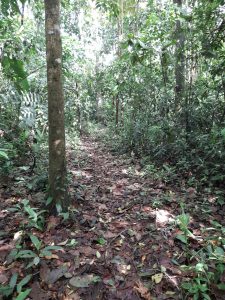Soil organic matter
Amber Anderson
- Discuss importance of organic matter in the soil
- Identify mechanisms of addition or loss
- Predict a management change’s impact on soil organic matter
Carbon cycle
Carbon dioxide is all around us, but plants convert that carbon into organic forms and remove it from the atmosphere. The soil is a significant storehouse for previous generation’s carbon, in a variety of different forms.
Organic matter
The term ‘organic matter’ is used to refer to things consisting of organic carbon-so anything that was alive. However, not all of these components are equal when considering function in soil. Some materials break down rapidly, releasing nutrients within a few months or years, while some carbon contained in organic structures have been in the soil for hundreds of years.
Impact on soil properties
Darker soil colors generally correlate to higher levels of organic matter in the soil. Organic matter is also helpful in other soil properties, such as nutrient and water holding capacity, resistance to compaction, and soil structure.
Decomposition
Decomposition rates vary based on soil conditions. As you make the environment more favorable for various microbes, decomposition will increase. Therefore, the most significant deposits of organic material are found where decomposition is slowed or stopped, but plant growth or other addition still occurs. One place might be a wetland-where anaerobic conditions slow decomposition, but water-tolerant plant species or even organisms like mosses are adding to the carbon pool.
- Oxygen: Anaerobic conditions decrease microbial activity and efficiency, so decomposition slows down significantly in these circumstances.
- Food source: In addition to being present, the food source will influence the rate of decomposition. For example, materials with large amounts of carbon per unit nitrogen-like wood-are harder to break down than fresh grass clippings.
- Temperature: Microbial activity, and therefore decomposition, is generally highest in the moderate temperatures.
- Organic matter accumulation in the tropical rainforest. Picture by: Arturo Flores
- Waterlogged soil in Costa Rica. Picture by: Arturo Flores
The first picture shows a thick layer of leaves accumulated on the soil. The exuberant vegetation is constantly growing throughout the year and rarely reduces its biomass production. The second picture shows how soils tend to be underwater when high precipitation events occur in a short period of time. It is possible to see how the organic matter is submerged with little to non-decomposition at all. High environmental humidity and waterlogged soils have low decomposition rates as microbial activity is limited. Also, the constant accumulation of new materials buries the old materials, and the process of decomposition starts again. However, it is important to know that although the soil might appear to have a high organic matter content, this is not completely true. Of more importance is the active soil organic matter, which has already been decomposed to some degree and actively contributes to the soil properties, such as in CEC and physical aggregation.
Think about a compost pile. What happens when only leaves are there? What happens if you add a pile of fresh greens (or leave them out on your counter/in the bottom of the fridge for too long)?
Assume that a 2 million pound acre furrow slice of soil (an acre to approximately 6 2/3″) contains 5% organic matter. How many pounds of organic matter exist in the area?
(2,000,000 x 0.05)
Since organic matter contains approximately 5% nitrogen, how much nitrogen is contained within that organic matter? To get this answer, we would take the previous question’s answer, as that is how much organic matter is contained in the acre furrow slice and multiply by the percent nitrogen.
(100,000 x 0.05)
If 3% of this was released per year, about how many pounds could be released? To get this answer, we would take the previous answer (lbs of nitrogen) and multiply by the amount released per year.
(5,000 x 0.03)
- The soil is an important carbon store
- Soil organic matter has a variety of benefits in the soil
- Management decisions impact organic matter levels and distribution



